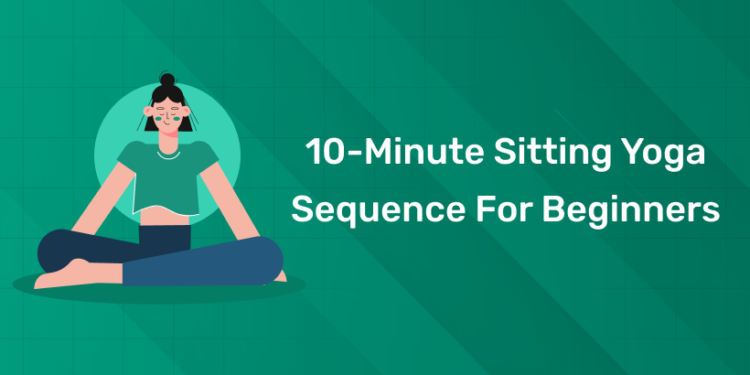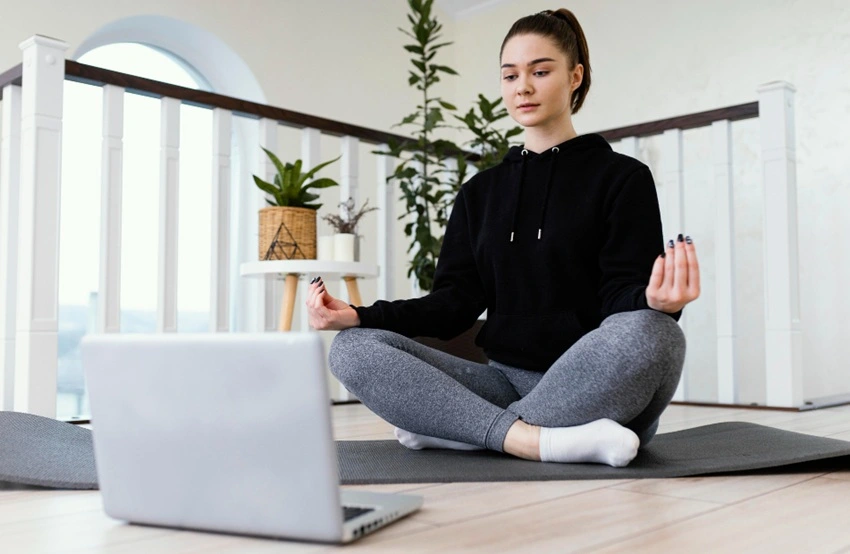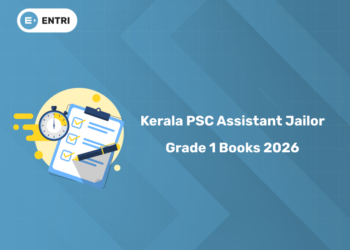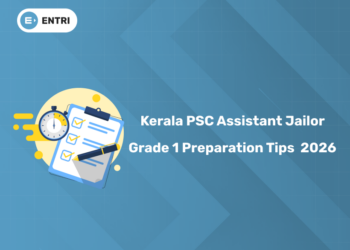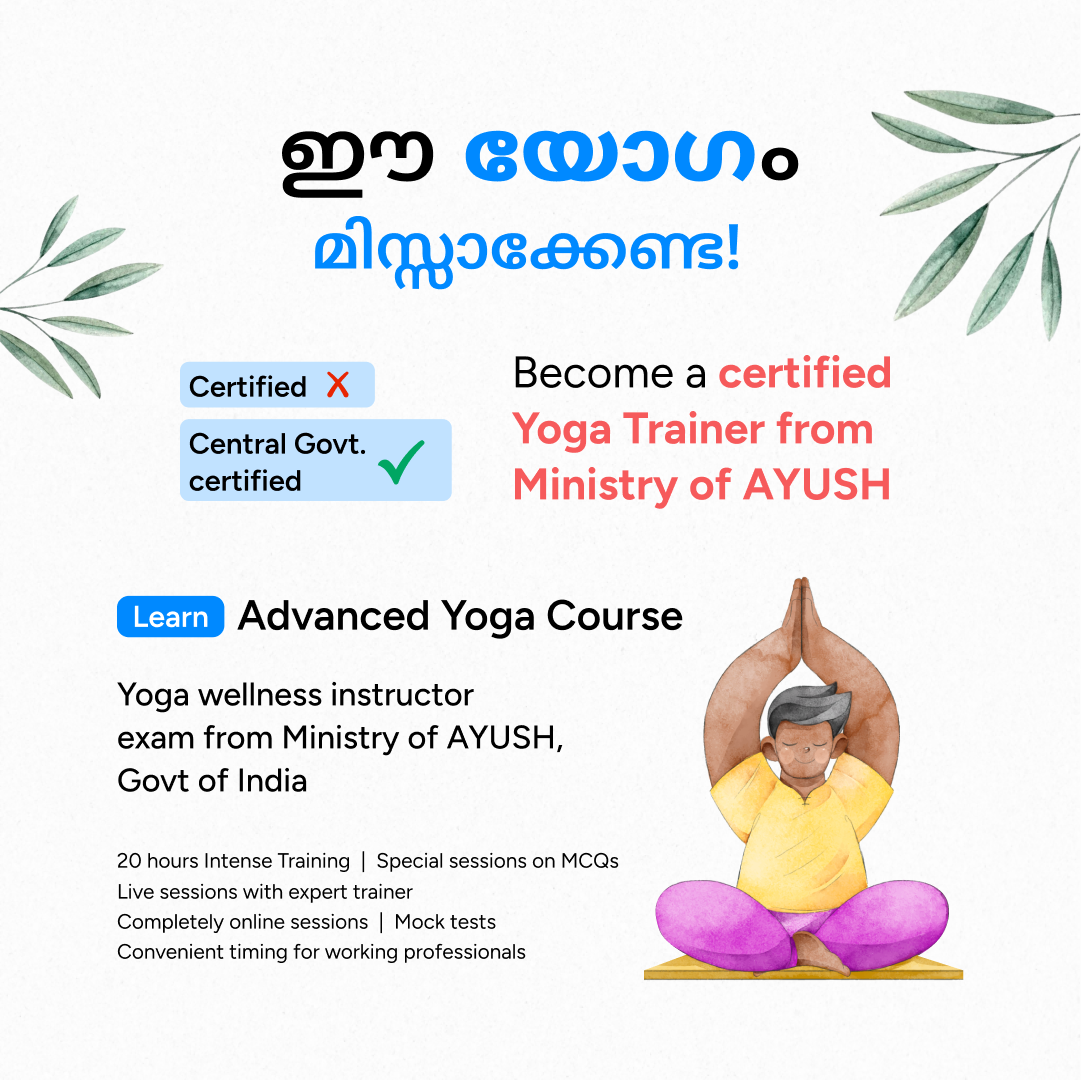Table of Contents
What, in a time where so many of us are sitting on the chair, staring at screens and working through endless tasks, our bodies and minds become stiff, tight and disconnected, it’s no wonder that our bodies and minds are stiff, stiff and disconnected. But here’s the good news: yoga doesn’t have to be a full hour or so. A quick 10-minute sitting yoga session may help you stretch, breathe more deeply, relax your nervous system and bring back the body. Take our guide as a beginner looking for a gentle practice or someone trying to learn yoga as a aspiring teacher.
Its meaning and uses are discussed, but we’ll explain why and how seated yoga works, how you get started, how to go about a beginner-friendly 10-minute flow, the benefits of training, and why real training such as Entri Yoga TTC, is important for learning and teaching.
Get Confident! Join Our Yoga Teacher Training Course!
Why Seated Yoga Works for Beginners and Busy Lives
Seated yoga poses often called “sitting asanas” are accessible, gentle and powerful. They allow you to practice anywhere: on your mat, on a cushion, in a chair or even during a break. Some key benefits:
- They require minimal space and no complex balancing or standing transitions.
- They promote spinal length, hip flexibility and ease in the lower back and legs. As one source notes, seated poses improve flexibility in the legs (hamstrings, quads), open hips and back, and serve as a stable base for deeper practice.
- They help relax the mind, support body awareness and foster mindfulness which scientific and lay sources highlight as strong outcomes of seated/“chair” yoga.
- Since many people spend most of their day sitting, these poses act as a counter-balance to sedentary habits, making them highly relevant in our current lifestyle.
In short: Seated yoga is a smart, pragmatic entry point for yoga. And for aspiring teachers, it’s an essential tool since many students will need or prefer sitting/grounded practices.
Preparing for Your 10-Minute Seated Practice
1: Which of these is the primary goal of yoga practice?
Before you begin this sequence, it is important to start getting ready.
- You’ll feel safe in a dark place for 10 minutes.
- If the floor is hard, or your hips are tight, use a yoga mat or folded blanket underneath your sitting bones.
- Wear soft clothing that allows you to move and breath freely.
- By the time you’re tall, close your eyes and relax in 3 slow deep breaths in through the nose, out through the nose and allow your shoulders to soften.
- Plan for the intention: “I give myself these ten minutes for calm”, or “I open space in body and mind.” Simple intention holds the practice together.
Become a Certified Yoga Instructor
Yoga Teacher Training Course by Entri App: Master authentic yoga techniques, earn certification, and build a successful career as a professional yoga instructor.
Join Now!The 10-Minute Seated Yoga Flow
Here is a straightforward sequence of six seated postures, each held for approximately the time indicated. You can adjust timing slightly (for example 1 minute instead of 1:30) based on your availability and comfort. The full loop adds up to about ten minutes.
Pose |
Duration |
How to Do It |
Focus & Benefits |
| 1. Sukhasana (Easy Pose) | 1 min | Sit cross-legged (or legs in front if cross-legged is uncomfortable). Spine tall, shoulders relaxed. Hands on knees or thighs. Close your eyes and breathe. | Establishes calm, connects with breath, sets the tone. |
| 2. Seated Side Stretch | 1 min (30s each side) | From Sukhasana, keep left hand on floor beside you, inhale right arm up, exhale and gently bend to the left. Return. Repeat on other side. | Opens the side body, ribs, waist; stimulates breath and mobility. |
| 3. Seated Spinal Twist | 1.5 min (45s each side) | Sit with legs crossed or in a comfortable seated pose. Place right hand behind you, left on right knee; inhale, lengthen spine, exhale twist gently to right. Return. Repeat left. | Enhances spinal flexibility, massages internal organs, and supports digestion and posture. |
| 4. Seated Forward Fold (Paschimottanasana variant) | 2 min | Extend both legs straight in front. Inhale arms up, exhale, hinge from the hips and fold forward toward feet/shins. Keep spine long. Let your head relax. | Stretches hamstrings/back, calms nervous system, encourages inner focus. |
| 5. Baddha Konasana (Bound Angle Pose) | 2 min | Bring soles of the feet together, knees fall wide. Hold feet with hands. Sit tall, breathe deeply. Option to gently flap knees like a butterfly. | Opens hips/groin, releases tension in lower body, fosters ease. |
| 6. Vajrasana (Thunderbolt Pose) + Meditation | 1.5 min | Kneel and sit back on heels (or sit on blanket if needed). Hands on thighs, spine erect. Close eyes, breathe slowly and observe body and breath. | Grounds the practice, balances digestion and mind, prepares body for transition back to day. |
After the sequence ends, remain seated for 30 seconds to a minute in a comfortable position just breathe and observe how your body/mind feel. Smile inward.
What Makes This Flow Effective
- Short and consistent: Even a brief ten-minute routine can reset your posture, release tension and shift your mindset.
- Seated = accessible: No standing or complex transitions means lower barrier to entry and higher chance you’ll stick with it.
- Full-body gentle stretch: We’ve touched sides, spine, hips, hamstrings and back covering major areas where sitting all day tends to cause stiffness.
- Mind–body integration: The flow includes stillness (Easy Pose), movement (side stretch/twist) and inward focus (forward fold/meditation) a holistic approach.
- Teacher-friendly: If you’re training as a yoga instructor, this is teachable as a short “desk yoga” or “morning reset” class variant.
Practical Tips for Students and Aspiring Teachers
For everyday practitioners:
- Try this daily or 4-5 times a week. Consistency beats length.
- If tight in the hips or knees, sit on a cushion to elevate the hips.
- If the forward fold is hard, bend knees or rest hands on a strap/blanket.
- Use it as a morning wake-up, mid-day break or evening wind-down.
- Tune into your breath: make exhalations longer than inhalations (e.g., inhale 4 counts, exhale 6) to shift into relaxation.
For aspiring yoga teachers:
- Note alignment cues: e.g., in seated forward fold, don’t round lower back from hips and lengthen spine.
- Notice how you guide breathing and stillness; mention themes like “release tension in hips,” “lengthen spine,” and “calm the nervous system.”
- Adapt the sequence for different populations: for office workers, for seniors (maybe using chair support), for global students.
- A deeper training like the Entri Yoga TTC Course will give you anatomy, sequencing logic, class planning skills and teaching confidence so you can teach short flows like this with clarity and safety.
Become a Certified Yoga Instructor
Yoga Teacher Training Course by Entri App: Master authentic yoga techniques, earn certification, and build a successful career as a professional yoga instructor.
Join Now!Why Training With Entri Yoga TTC Adds Value
While this ten-minute flow gives a strong starting point, if you intend to deepen your personal practice or teach others, structured training matters. The Entri Yoga TTC Course provides:
- Detailed anatomy of seated posture mechanics, enabling you to cue effectively and offer safe modifications.
- Sequencing frameworks so you understand not just “which poses” but why and in what order.
- Skills in breathing (pranayama), relaxation techniques and teaching pedagogy so your students feel seen, supported and safe.
- Certification and credibility especially useful if your goal is to teach corporate yoga, online yoga or yoga for beginners.
In short, build your foundation with simple flows. Then elevate into teaching with grounded knowledge and confidence.
Key Takeaways
- You dont need to be stuck on a mat for hours to feel the real benefits of yoga – a simple 10-minute seated sequence can actually work pretty well.
- Sitting asanas are a great place to start because theyre beginner-friendly, super accessible and will really help you out with flexibility, posture and getting more relaxed.
- A good flow needs to balance stillness, gentle movements and inside focus, addressing bad posture, stiff hips and getting your nervous system under control.
- Just a little bit of practice goes a long way – 10 minutes 4-5 times a week can actually start to make a positive difference.
- If you want to teach these routines or branch out into other styles, its worth investing in some proper training – the Entri Yoga TTC Course is a good place to start.
- Remember the goal is to be aware, breathe and just ease into it – more about making that connection and being fully present than getting into perfect poses.
Conclusion
While some might call this a luxury, it is what makes us all extremely needy in the face of a world that never seems to slow down. This simple 10-minute class of seated yoga is like opening to all that – whether you’re ready to start out or you’re going out on a long weekend, taking care of your body in the morning, or just in a class for the beginner, the flow is flexible and solid.
Just take a short 10 minute nap. Sit tall, breathe deeply and stretch your spine to lengthen your hips and quietly relax your mind a bit. If you’re wondering how to get going and want to go further, maybe if you want to practice a bit more, perhaps taking a training course in Entri Yoga TTC Course and this will give you the tools necessary to learn more, improve your teaching and hopefully even give you confidence to share yoga with others.
Become a Certified Yoga Instructor
Yoga Teacher Training Course by Entri App: Master authentic yoga techniques, earn certification, and build a successful career as a professional yoga instructor.
Join Now!Frequently Asked Questions
What is a sitting yoga sequence?
A sitting yoga sequence is a flow of yoga poses performed while seated, helping improve flexibility, posture, and mental calmness without the need to stand or balance.
Can beginners do sitting yoga?
Yes, sitting yoga is perfect for beginners. It includes simple stretches and breathing techniques that can be done on a chair or mat with minimal effort.
How long should I do sitting yoga daily?
Just 10–15 minutes of daily sitting yoga can greatly improve circulation, reduce stress, and enhance focus, especially for people who work long hours at a desk.
What are the benefits of sitting yoga poses?
Sitting yoga improves spine alignment, boosts digestion, reduces anxiety, and enhances mindfulness. It also relieves back and neck tension caused by prolonged sitting.
Do I need yoga experience for this 10-minute sequence?
No experience is required. This sequence is designed for complete beginners and can be safely practised under the guidance of online or in-person yoga instructors.
Is sitting yoga suitable for seniors or people with mobility issues?
Yes, sitting yoga is gentle and adaptable. Seniors or those with limited mobility can modify poses using cushions or chairs for support.
Which breathing techniques work best with sitting yoga?
Deep diaphragmatic breathing, alternate nostril breathing (Nadi Shodhana), and mindful inhalation-exhalation are perfect for seated yoga flows.
Why should I join Entri’s Yoga TTC Course?
Entri’s Yoga TTC Course offers a structured and affordable way to become a certified yoga instructor. With bilingual guidance, expert mentors, and placement support, it’s ideal for anyone looking to build a career in yoga teaching.


